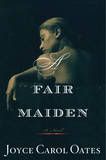A Fair Maiden / Joyce Carol Oates
 Houghton Mifflin Harcourt / January 2010
Houghton Mifflin Harcourt / January 2010
Reviewed by: T.E. Lyons
This is a fable of generations, which clash so as to sort out their places with each other — and with the ages. Social classes play an important part, too. Inspiration, art, romantic love, familial obligation and lust fill out the burgeoning cast of themes that all have their say in this slender volume. And it wouldn’t truly be a gothic work if it didn’t have death standing by – not tallest, but most unwavering – to proclaim itself as the destination of all.
For avid fans of horror, A Fair Maiden might seem like an odd tangent. Professor Oates of Princeton – to most of her readers, the most unlikely of Stoker Award winners – is offering a short novel that can be seen as a character study of a troubled teenage girl from a small New Jersey town. The time is the present — but more importantly, it is one of those summers where everything changes for a teenage protagonist. Though this setting is indicative of mainstream fiction, the narrative structure by which the plot plays out has much of the classic gothic blueprint. The past will reach out from the grave to affect the girl’s future.
If she has any future, that is. For agents of the past are pulling at her, though in subtle ways. Oates’ very realistic setting of a semi-rootless summer-job situation demonstrates that the ties and opportunities of the present are very susceptible to seduction by the ever-romantic shadows of the past.
What’s brilliant about the portrayal of Katya – and why aspiring writers of dark fiction should consider seeking out this book – is that her thoughts and feelings come across with an even greater realism than her carefully drawn situation. While Oates likens Katya to the enigmatic title character of the traditional ballad “Barbara Allen,” the author puts the reader completely in touch with the convictions and impulses that are driving her modern-day protagonist. This is a 16-year-old pushed and pulled by demands that run beyond her age-appropriate emotional development. In defensive reaction to all of her external stresses, she makes decisions that pull her deeper into the web of an elderly man who wields charm and power. The girl turns away from him, multiple times, through a range of reasons as well as capricious whims — only to face other demands on her that show the old man to be as much an opportunity as he is a danger.
The ghosts of the past may be putting an unsuspecting protagonist into an unfamiliar and dangerous atmosphere, but usually such a classic gothic plot seems underdressed if there aren’t some scenes that pile on the sheer otherness. Even Austen did it (in Northanger Abbey). Oates will have just about none of that, apparently. It’s an everyday contemporary setting, and the otherness in this book is more a product of a teen’s fickle allegiances and nascent ambitions as it is the influence of the dead girls whose photos sit near the piano at the oceanfront mansion.
Oates also defies gothic conventions with some pacing tricks. She is gradual and deliberate (mostly slow, and intentionally unsteady) in how she introduces sex and death into the story. Strangest of all, the author announces that the ending will be abrupt, and makes good on her word. Too good, as far as this reader is concerned. After learning to enjoy gothic storytelling in which so many of the predictable comforts were subverted, it was painful but also a little disappointing when I had to close the cover just at the point that a body was growing cold.
Purchase A Fair Maiden by Joyce Carol Oates.



